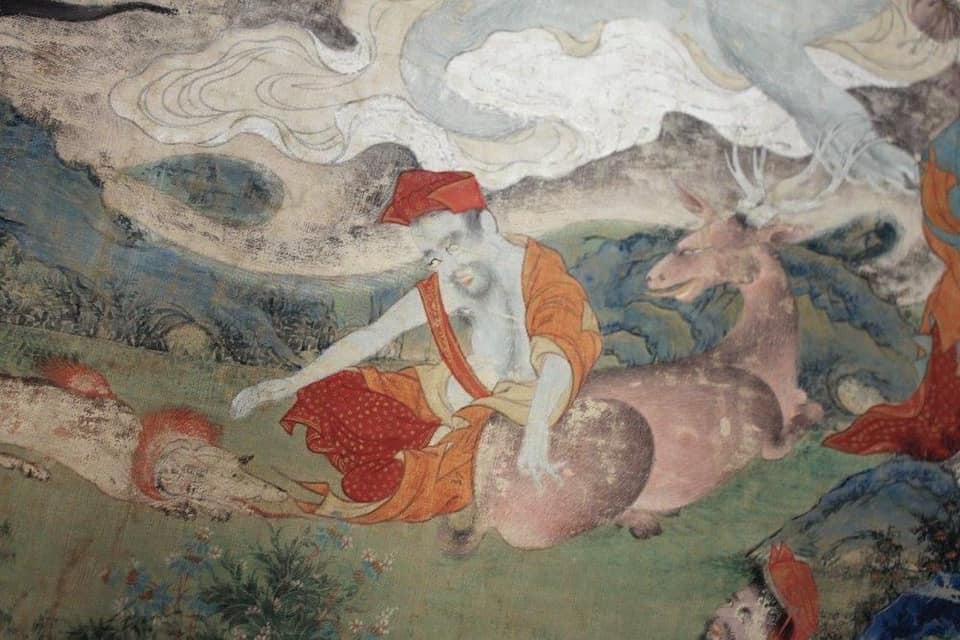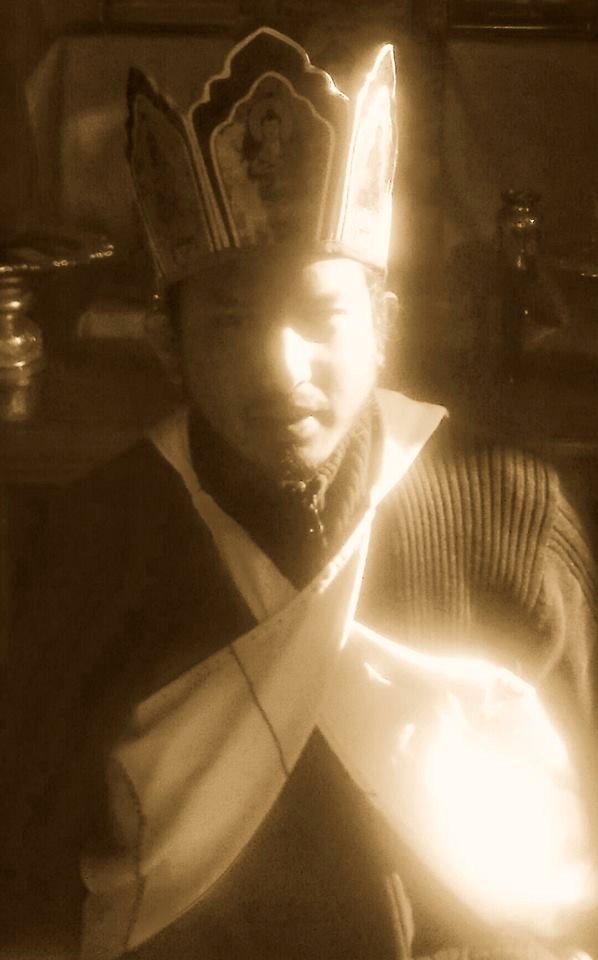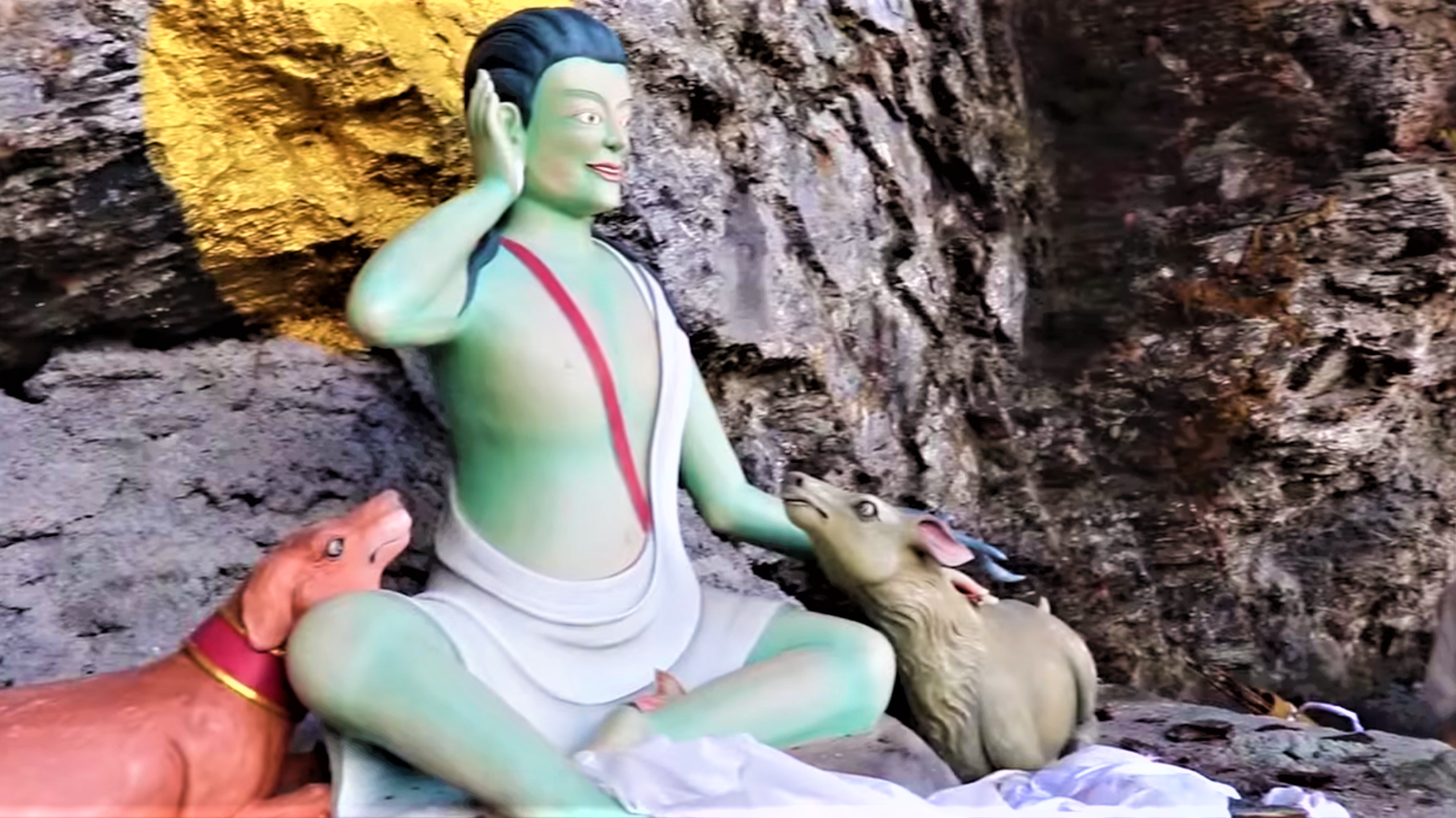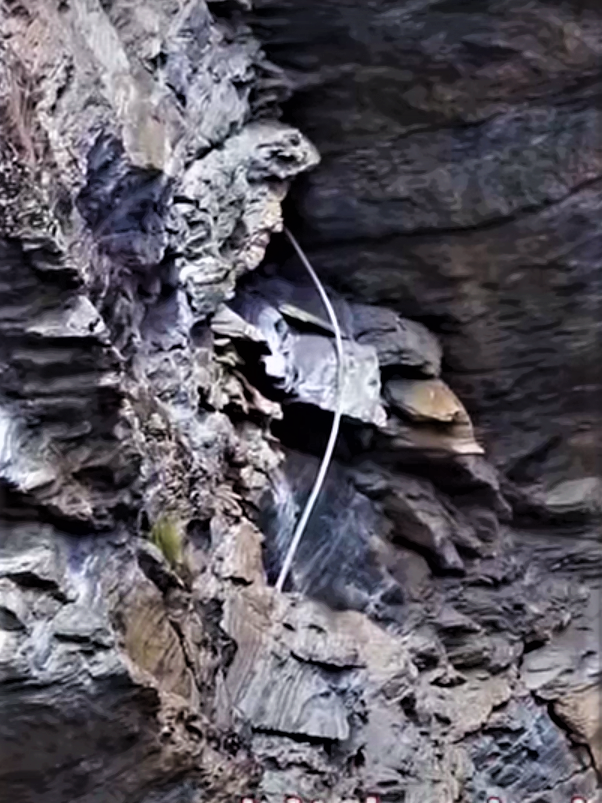
It is a pleasure and honour to share a new English-language edition of Milarepa’s Songs to the Hunter and Animals, which (unlike previous translations) includes the Tibetan script and phonetics, as well as an exclusive poem, foreword and interview from Dharma friend, and living holder of the hunter’s lineage, the 37th Khyira Kagyu Choge Chiba (38 years old, born in Tibetan Dog-Water Year). His father is the 36th Khyira Kagyu Choge Chiba, born 70 years ago in 1951 in the Tibetan Rabbit Year of Metal and passed away in 2012. As I have written about here, heir lineage comes directly from one of the eight heart disciples of Milarepa, the hunter, Gonpo Khyira Dorje. As part of an effort to preserve and promote this little-known lineage, as well as the wisdom contained within these songs, this new translation and publication has been created for free use and download here:

The Khyira Kagyu lineage

I first made friends with the 37th Khyira (see photo above), almost two years ago, due to his interest in this website and work on Kālacakra. At that time, I had no idea such a lineage existed and was alive and well. It was only recently, I discovered this, when he asked me to put into phonetics the Tibetan songs that Milarepa had sung to his ancestor and animals. A sign of his humility and realisation, no doubt. There is a misperception in Tibetan Buddhist circles that the main lineage holders are Tibetans, however the Newar Buddhist lineages of Vajrayana are still maintained in many parts of Nepal to this day.
Thirty seven generations ago,
my forefather hit an arrow
to you and it was missed.
I don’t know,
how could it be missed,
because master of archery was he.
People know it not,
That there was an arrow
hit by you too
and it wasn’t missed.
The arrow that penetrated
the heart of my ancestor,
who can realize now,
It is still here,
in my heart deep.
The arrow of alchemy,
that you shot
Is such a miracle,
that I am happy to carry it.
My homage to you,
Master Milarepa,
Please bless me.
Milaraja Bhraja Jya (Homage to King Milarepa)
Khyiraba Bhraja Jya (Homage to Father Khyira)
In his foreword, he explains that:
“Because it was a very secret ear-whispered, one to one tradition, I was until now very reluctant even to speak of the existence of this lineage to anybody. Yet, these songs and incidents of Milaraja could inspire, lead and transform many people onto the path of Dharma, Brahmavihārās and Nirvāṇa. So even though there were two translations already, one by Chang and another, more recent one, by Stagg, I strongly felt there was a need for a third one with the original Tibetan and phonetics. I did not know who could do it, until a very capable and courageous Adele said she would, and that too without taking any charge/money but just as a dharma act of generosity. With my family Kuladevata Chakrasamvara and Kulaguru Milaraja, I do pray and wish for the benefit of her and to all those who will read her.”
Milarepa’s Songs to the Hunter and Animals
 The Cave at Nyi Shang
The Cave at Nyi Shang
These songs here come from the time when Milarepa was in Nyi Shang, a region near Bragha, Manang, Nepal. Here is a photo taken of a statue (and the hunter’s bow and arrow) outside the cave where Milarepa is said to have been meditating, where the hunter offered him his bow and arrow and animals. The statue was apparently flown there in 2004 and there is a small monastery there. It has become a place of pilgrimage.
According to Milarepa’s Treasury of Lives biography:
“Many of Milarepa’s most famous retreat locations were said to have been previously inhabited by Padmasambhava himself. Tsangnyon Heruka’s reckoning of Milarepa’s meditation sites therefore reveals a process of spiritual re-colonization, one that effectively claimed much of the Himalayan border for Milarepa’s lineage. Three famous sacred sites of southern and western Tibet – Tsāri (tsA ri), Labchi (la phyi), and Kailāsa (ti se) – are said to have been established or prophesied by Milarepa, and all three later became important Kagyu retreat and pilgrimage centers, identified as Himālaya/Himavat, Godāvarī, and Cāritra/Devīkoṭa from the list of twenty-four pīṭhas of the Cakrasaṃvara Tantra, as well as the maṇḍalas of Cakrasaṃvara’s body, speech, and mind. Drakar Taso became in important monastic institution and printing house under the direction of Tsangnyon Heruka’s disciple Lhatsun Rinchen Namgyel (lha btsun rin chen rnam rgyal, 1473-1557).”
The Songs

While Milarepa was in Nyi Shang, he was disturbed in his meditation by a deer that was being chased by a dog, which in turn was being followed by a hunter named Khyira Gonpo Dorje. Out of great compassion for the deer, and the dog, showing his immense kindness to animals, he sang them songs which relieved them from their suffering and led them to liberation. Then, Milarepa did not allow the hunter, whose dog was chasing the deer. to kill it and so the hunter tried to kill Milarepa. His arrow could not harm Milarepa, yet instead of being angry with the hunter and rejecting him, he also sang to him and helped him completely turn his mind to dharma and attain full awakening. Milarepa also had a great influence upon the people of that region. Below are the contents of the booklet:
Contents
Foreword.
Introduction. 8
MILAREPA’S SONGS TO THE HUNTER AND ANIMALS. 14
Song to the Deer. 15
Song to the Dog. 18
The Hunter’s Offering. 30
Mila’s Song of the Seasons. 35
Mila’s Request for the Hunter to Remain. 38
Mila’s Instructions. 41
The Text
Milarepa’s songs to Khyira the Hunter were first translated into English and included within The Hundred Thousand Songs of Milarepa: The Life-Story and Teaching of the Greatest Poet-Saint Ever to Appear in the History of Buddhism (1965) by Garma C. C. Chang. Although that translation was done quite a while ago, and is inaccurate in places (or not close to the original Tibetan), as I was able to get an online copy, it proved an extremely valuable guide in producing this translation and I am grateful for it. There is also a more recent translation of the songs by Christopher Stagg (Shambala Publications, 2017), which is closer to the original Tibetan, but also does not include the Tibetan or phonetics. The Tibetan text I used for this edition is from an Anthology of Tibetan Medieval Literature[1]. I have not signficantly re-worked the previous translations of the narrative sections between the songs but focused on the songs themselves, and where suitable, kept close the repetitions of words in the original Tibetan. There is often a temptation for native English translators to use poetic or sophisticated words, but I believe that Mila’s songs were sung in such simple, straightforward language for a reason, and should be kept so.
A preserved 14th Century manuscript of Mila’s songs in Tibetan can be seen here at the British Library. The manuscript on display is an illustrated version created about a century before the well-known printed edition published in the 16th century by a master known as the ‘Madman from Tsang’.
“Here is an excerpt from one of the songs:
འོ་ན་ཉོན་ཧཱང་གསོན་དང་ཁྱི་ར་བ། །
o na nyön hang sön dang khyi ra wa
འབྲུག་འུར་སྒྲ་ཆེ་ཡང་སྟོང་སྒྲ་ཡིན། །
druk ur dra ché yang tong dra yin
འཇའ་འཇའ་ཁ་དོག་ལེགས་ཀྱང་ཡལ་ནས་འགྲོ། །
ja ja kha dok lek kyang yel né dro
འཇིག་རྟེན་ཉམས་སུ་དགའ་ཡང་རྨི་ལམ་ཙམ། །
jik ten nyam su ga yang mi lam tsam
འདོད་ཡོན་བདེ་བ་ཆེ་ཡང་སྡིག་པའི་རྒྱུ། །
dö yön dewa ché yang dik pé gyu
འདུས་བྱས་རྟག་རྟག་འདྲ་ཡང་མྱུར་དུ་འཇིག །
dü jé tak tak dra yang nyur du jik
Listen and pay heed, huntsman!
Even though thunder bellows, it is empty sound;
Even though the rainbow is finely coloured, it fades away.
The pleasures of this world are like dream-visions;
Though very blissful, they cause negativity.
The compounded seems permanent, yet speedily disintegrates.
རྫས་ཁ་སང་ཡོད་པ་དེ་རིང་མེད། །
dzé kha sang yö pa dé ring mé
མི་ན་ནིང་ཡོད་པ་ད་ལོ་ཤི། །
mi na ning yö pa da lo shi
གྲོགས་བཟང་པོ་ཡོད་པ་དགྲ་རུ་ལྡང་། །
drok zang po yö pa dra ru dang
ཟས་ཕན་པར་ཟོས་པ་དུག་ཏུ་འགྲོ། །
zé phen par zö pa duk tu dro
དྲིན་བཟང་པོས་བསྐྱངས་པ་ཁ་གྱོད་ཆེ། །
drin zang pö kyang pa kha gyö ché
Yesterday, one had wealth, but today, nothing.
Last year, one was alive, this year, one dies.
Excellent friends turn into vicious enemies.
Nourishing food becomes poison.
Kind benefactors breed disputes and complaints.
སྡིག་རང་གིས་བྱས་པ་རང་ལ་གནོད། །
dik rang gi jé pa rang la nö
ཁྱོད་མགོ་བརྒྱའི་ནང་ནས་རང་མགོ་གཅེས། །
khyö go gyé nang né rang go ché
ཕྱག་སོར་མོ་བཅུ་ལ་གང་བཅད་ཚ། །
chak sor mo chu la gang ché tsa
བཟའ་མང་ནང་ནས་རང་ཉིད་གཅེས། །
za mang nang né rang nyi ché
རང་མགོ་འདོན་པའི་དུས་ལ་བབ། །
rang go dön pé dü la bap
ཚེ་འདི་མི་རྟག་མྱུར་དུ་འཆི། །
tshé di mi tak nyur du chi
Negativities you commit, harm only yourself.
Among one hundred heads, you value your own.
Out of ten fingers, whichever is cut is painful.
Among all your family, you cherish yourself.
The time has come for you to help yourself.
Life is impermanent and death comes quickly.
ཆོས་ལ་ཕྱི་བཤོལ་བྱར་མི་རུང་། །
chö la chi shöl jar mi rung
བརྩེ་བའི་གཉེན་གྱིས་འཁོར་བར་འཕེན། །
tsewé nyen gyi khorwar phen
བླ་མ་བསྟེན་པའི་དུས་ལ་བབ། །
la ma ten pé dü la bap
ཚེ་འདི་རུ་བདེ་ལ་ཕྱི་མར་སྐྱིད། །
tshé di ru dé la chi mar kyi
དམ་ཆོས་བྱེད་པའི་དུས་ལ་བབ། །
dam chö jé pé dü la bap
It is not suitable to postpone practice.
Loved ones hurl you into samsara.
The time has come to rely on a Guru!
To have bliss this life and be happy the next,
The time has come to practice Dharma!”
May it be of benefit! Adele Tomlin, June 2020.
[1] At TBRC: bar dus rtsom rig gces bsgrigs, W1KG6095:1:21: mi rigs dpe skrun khang 2008.


